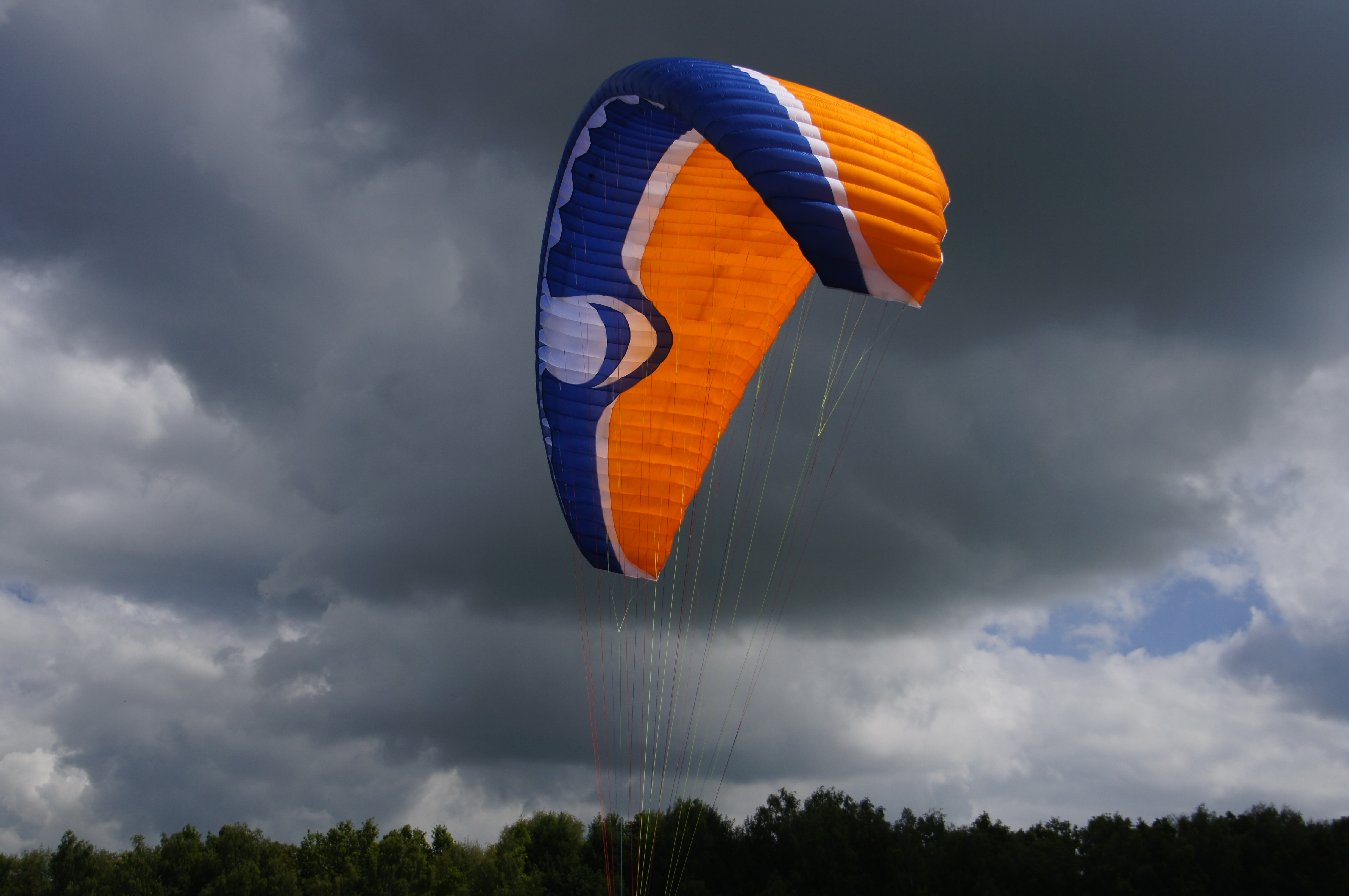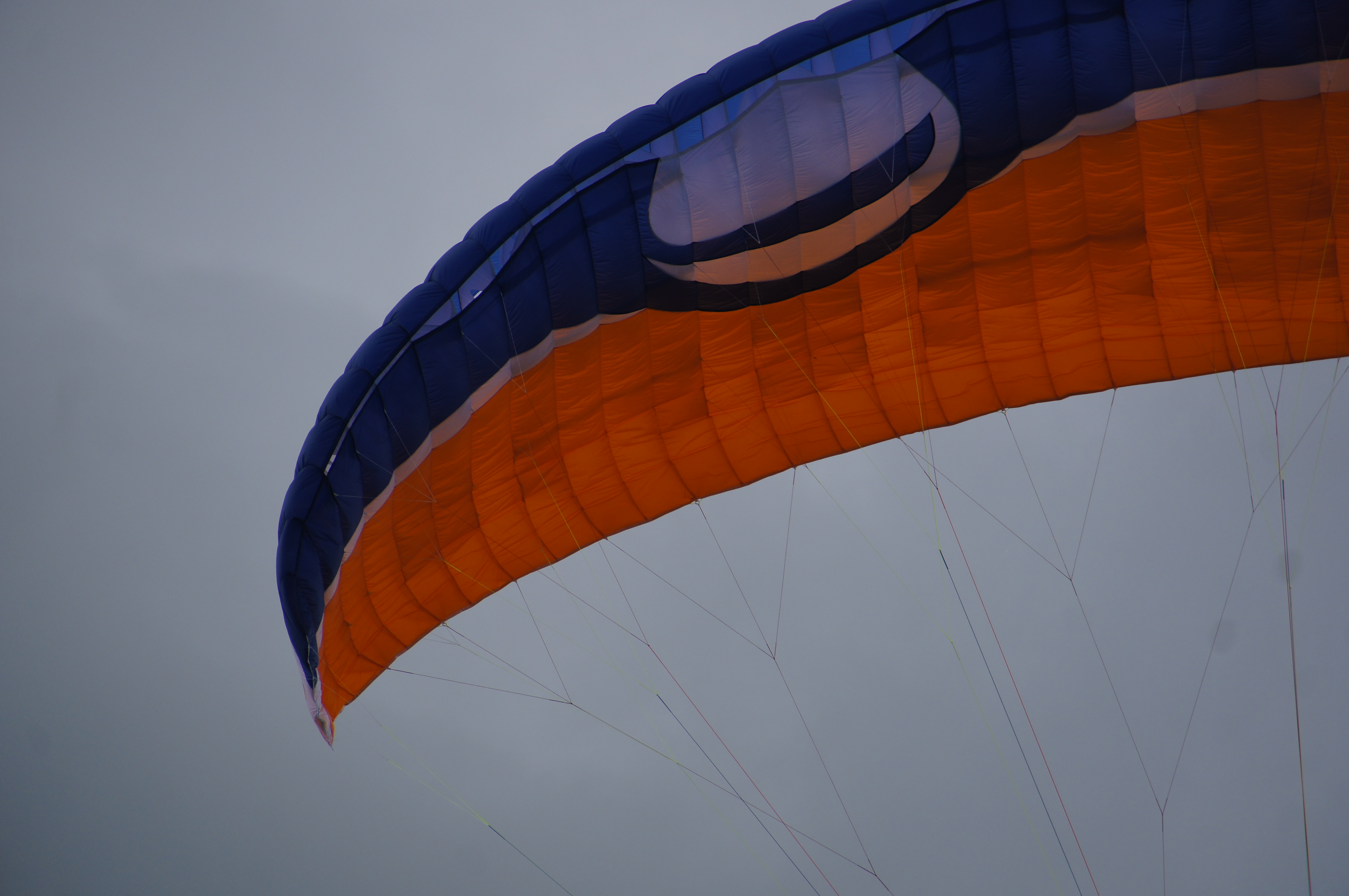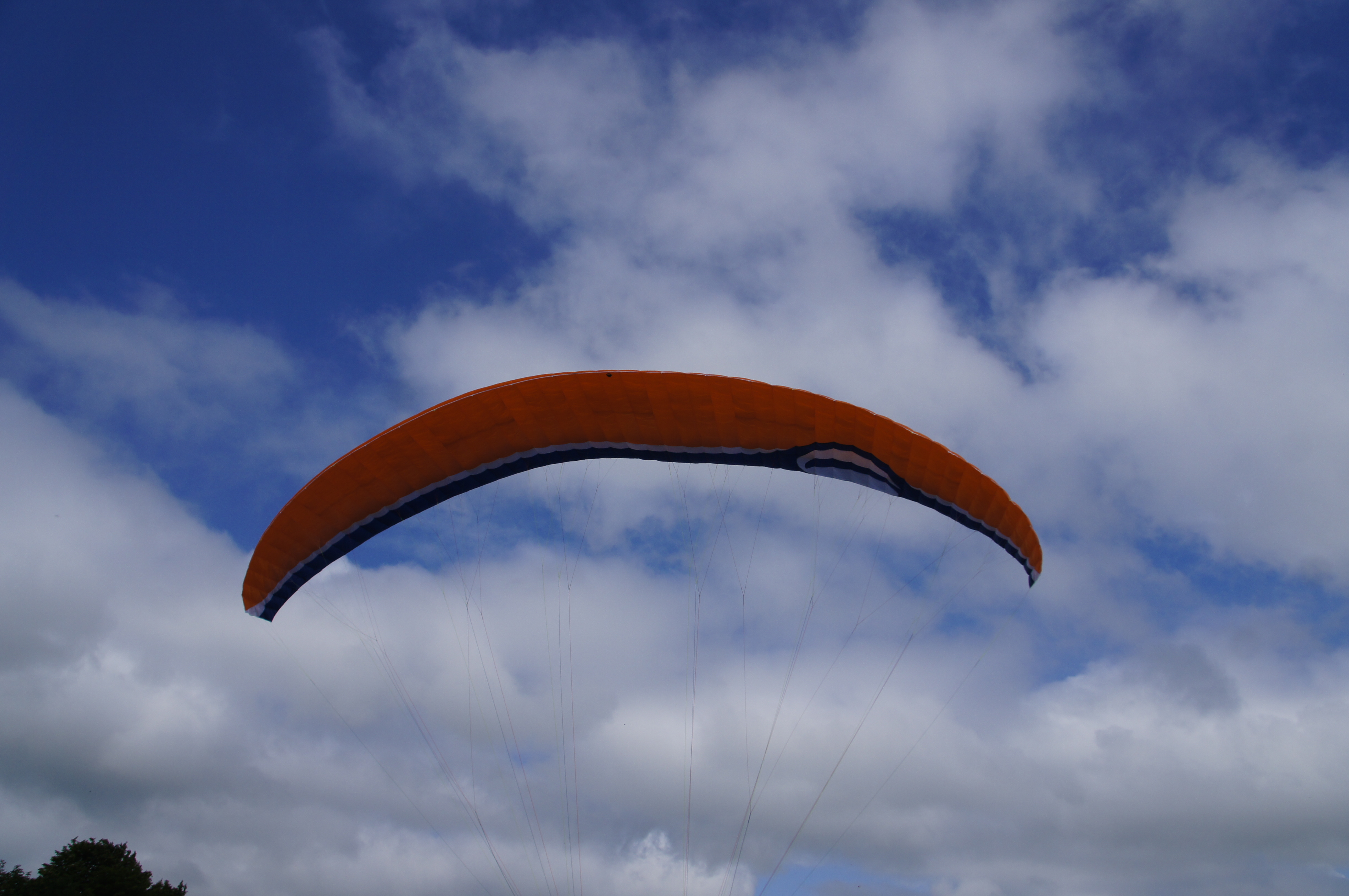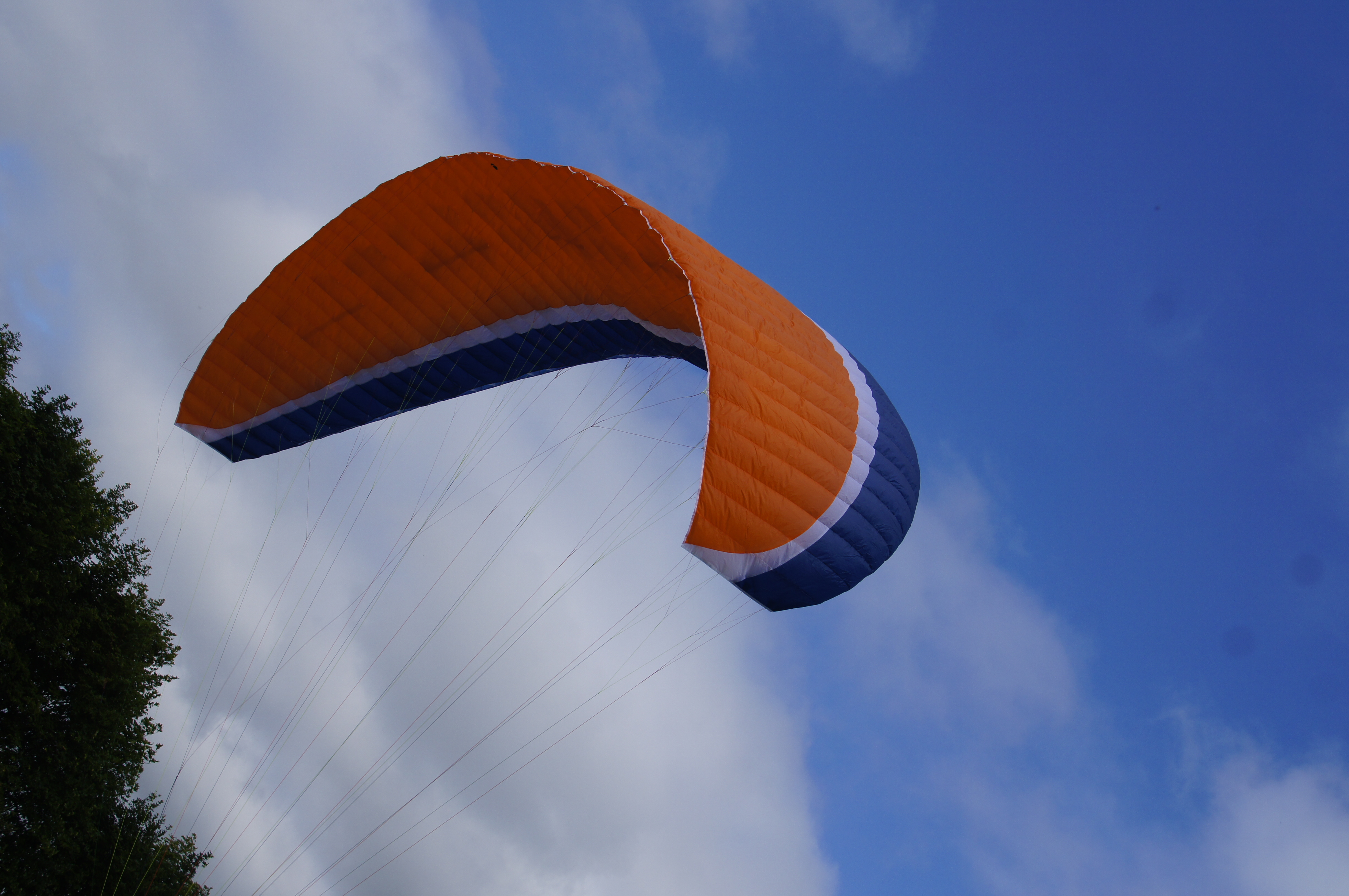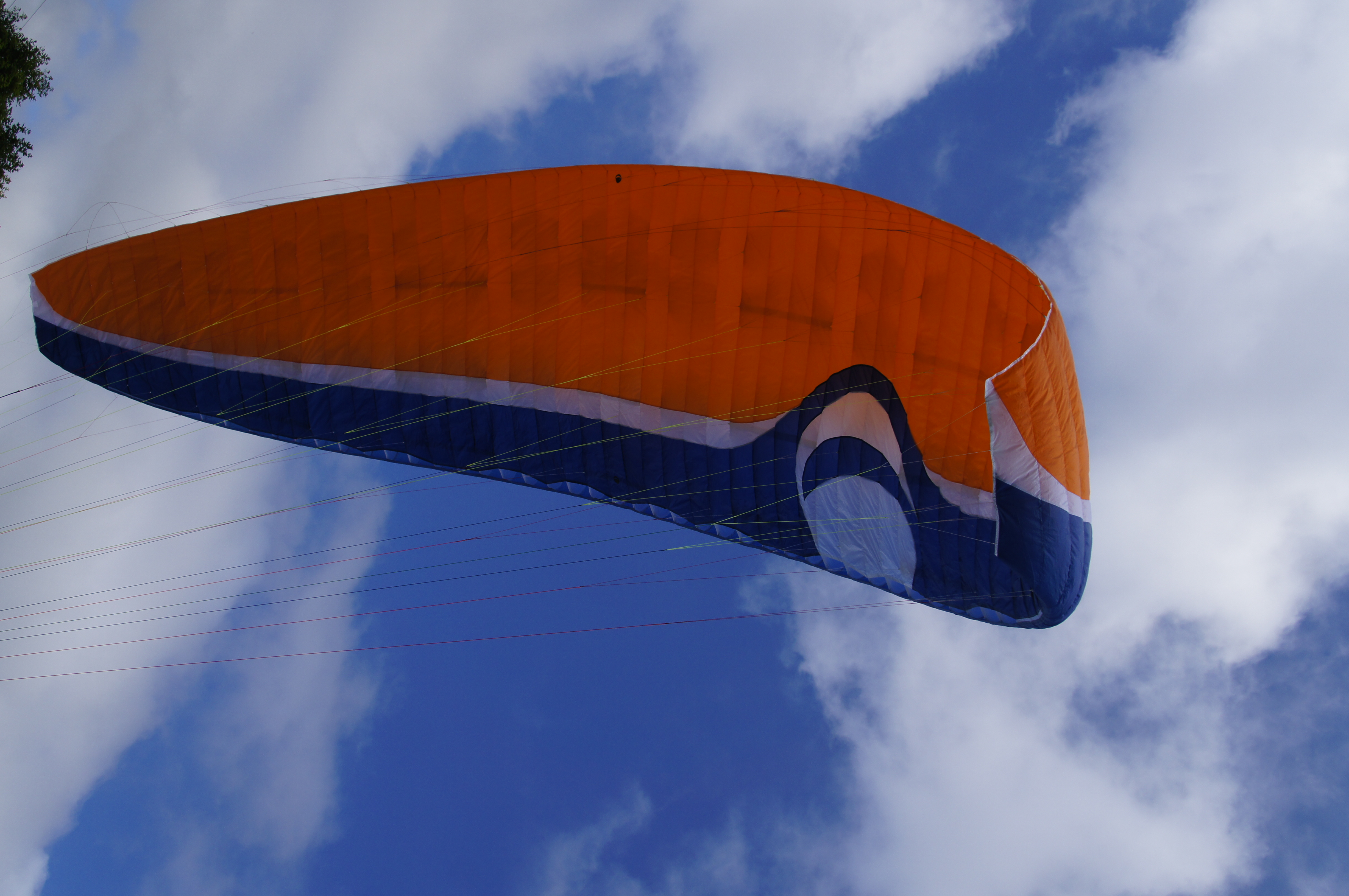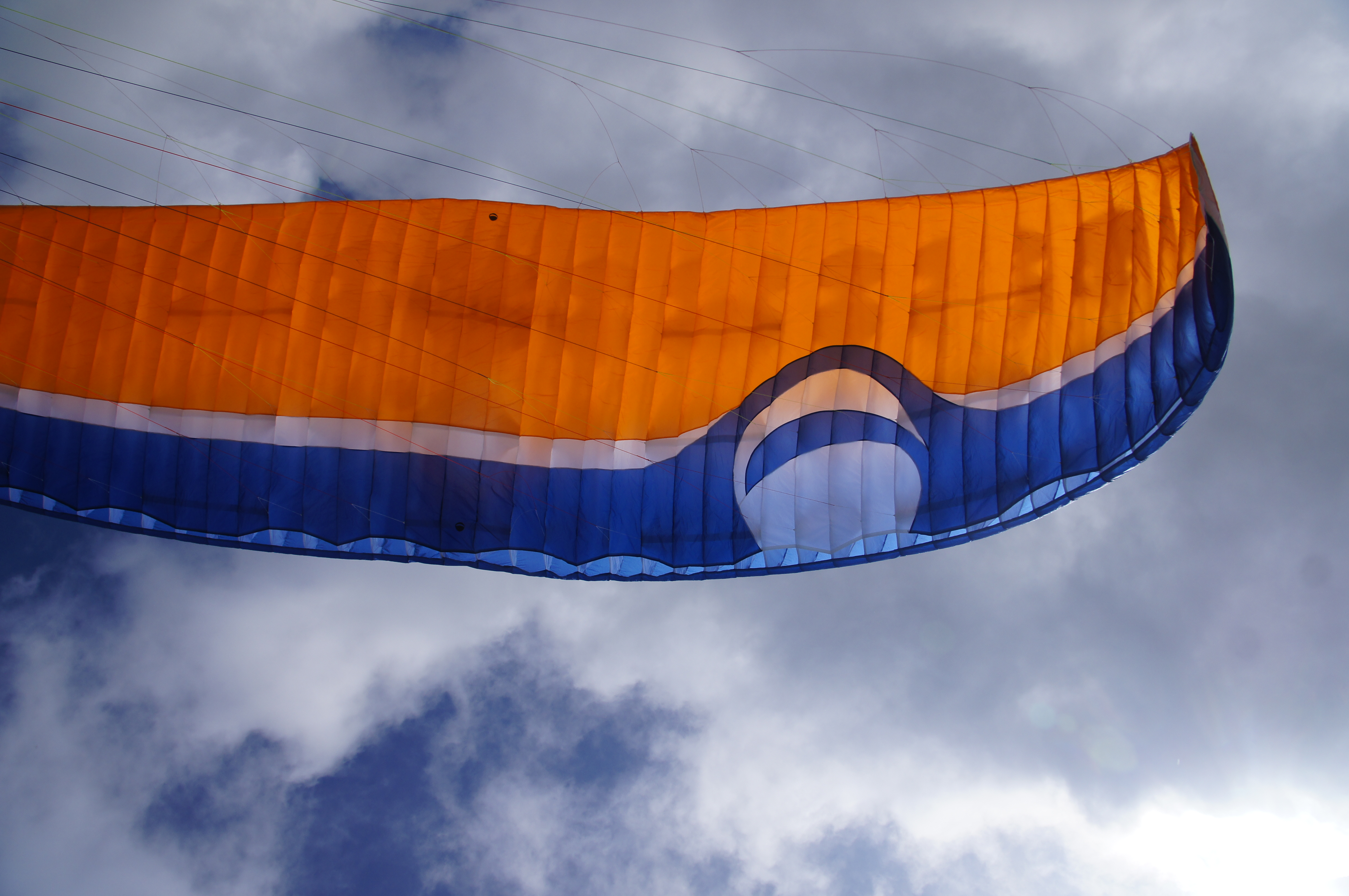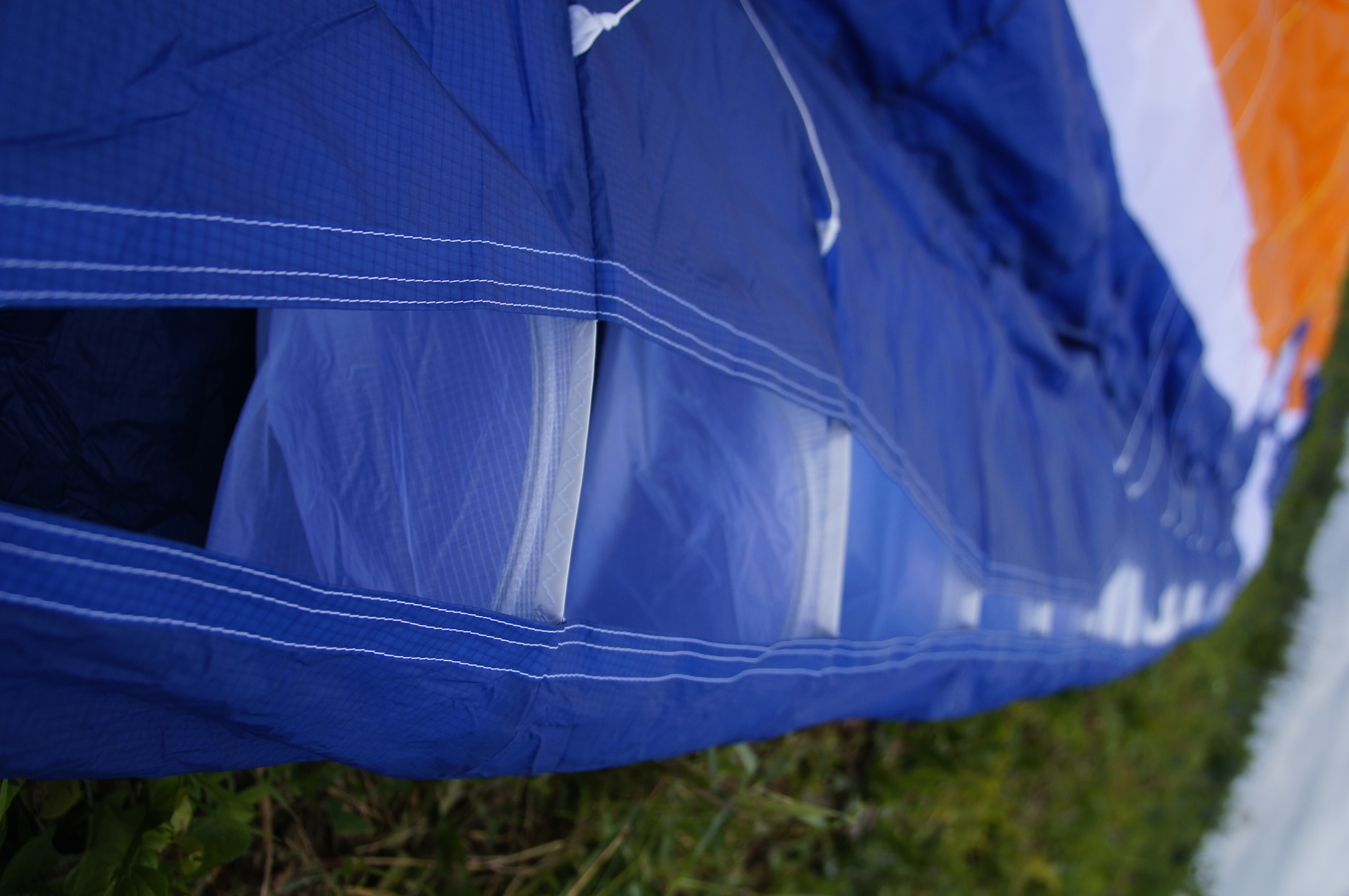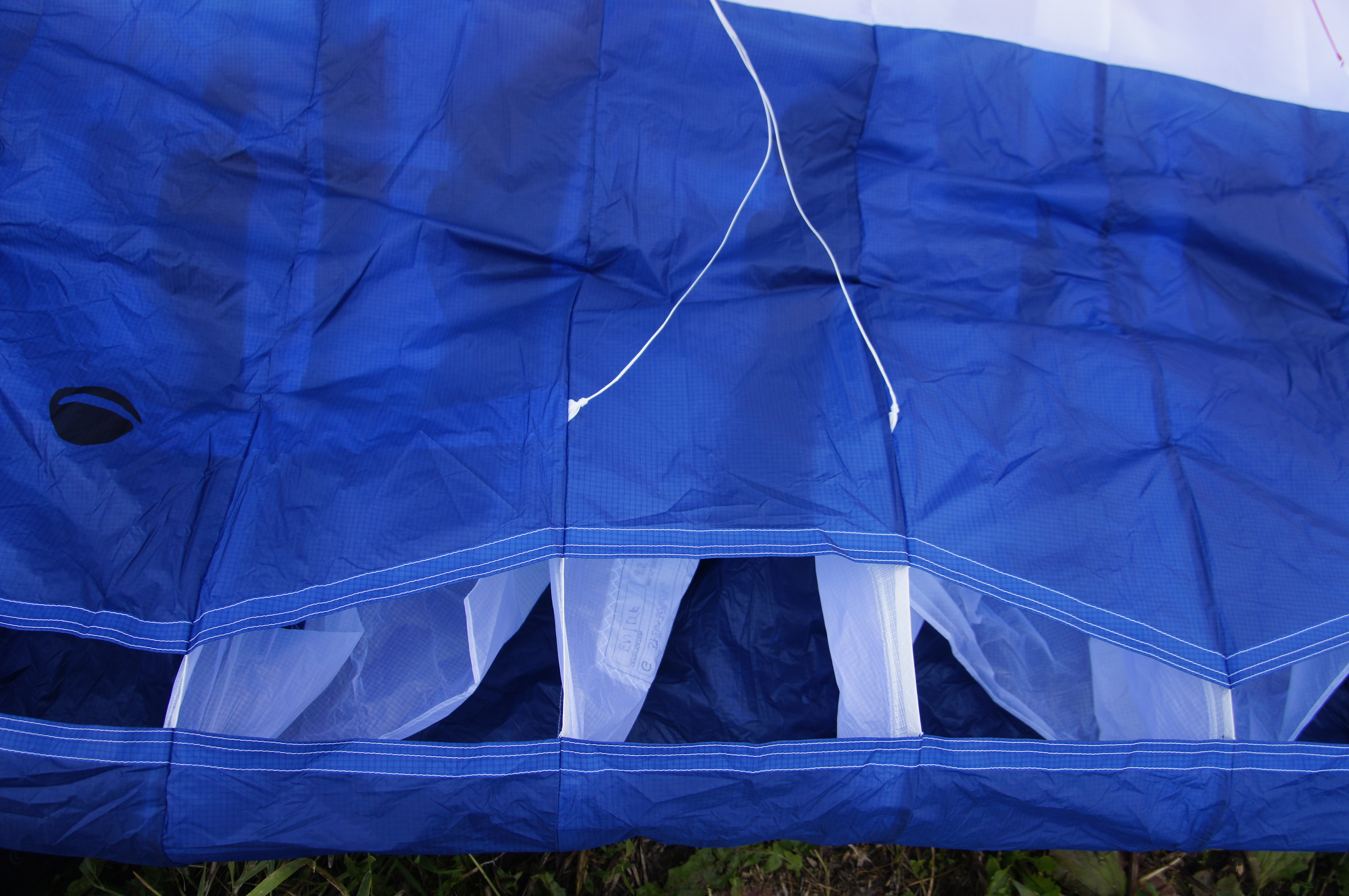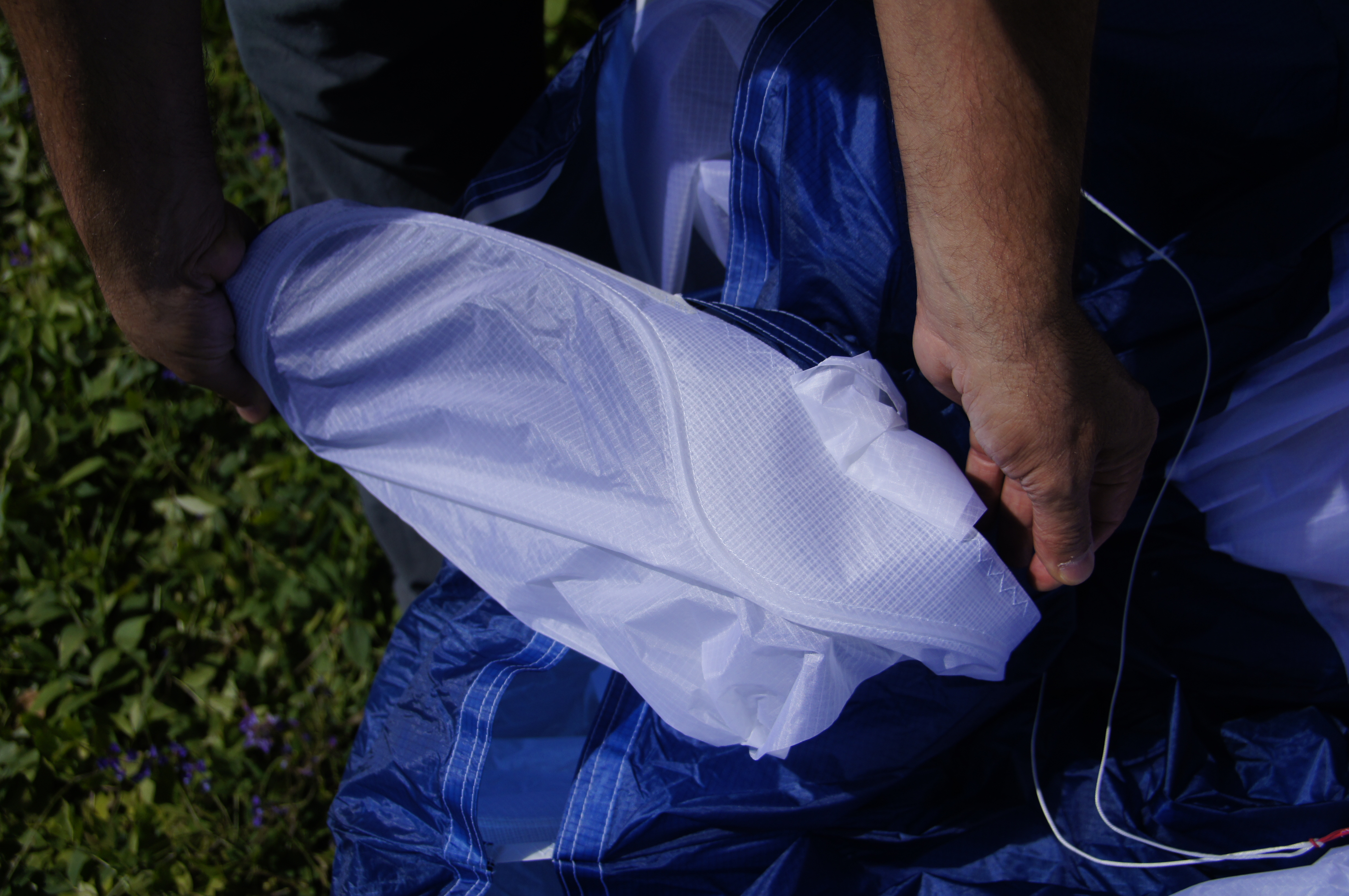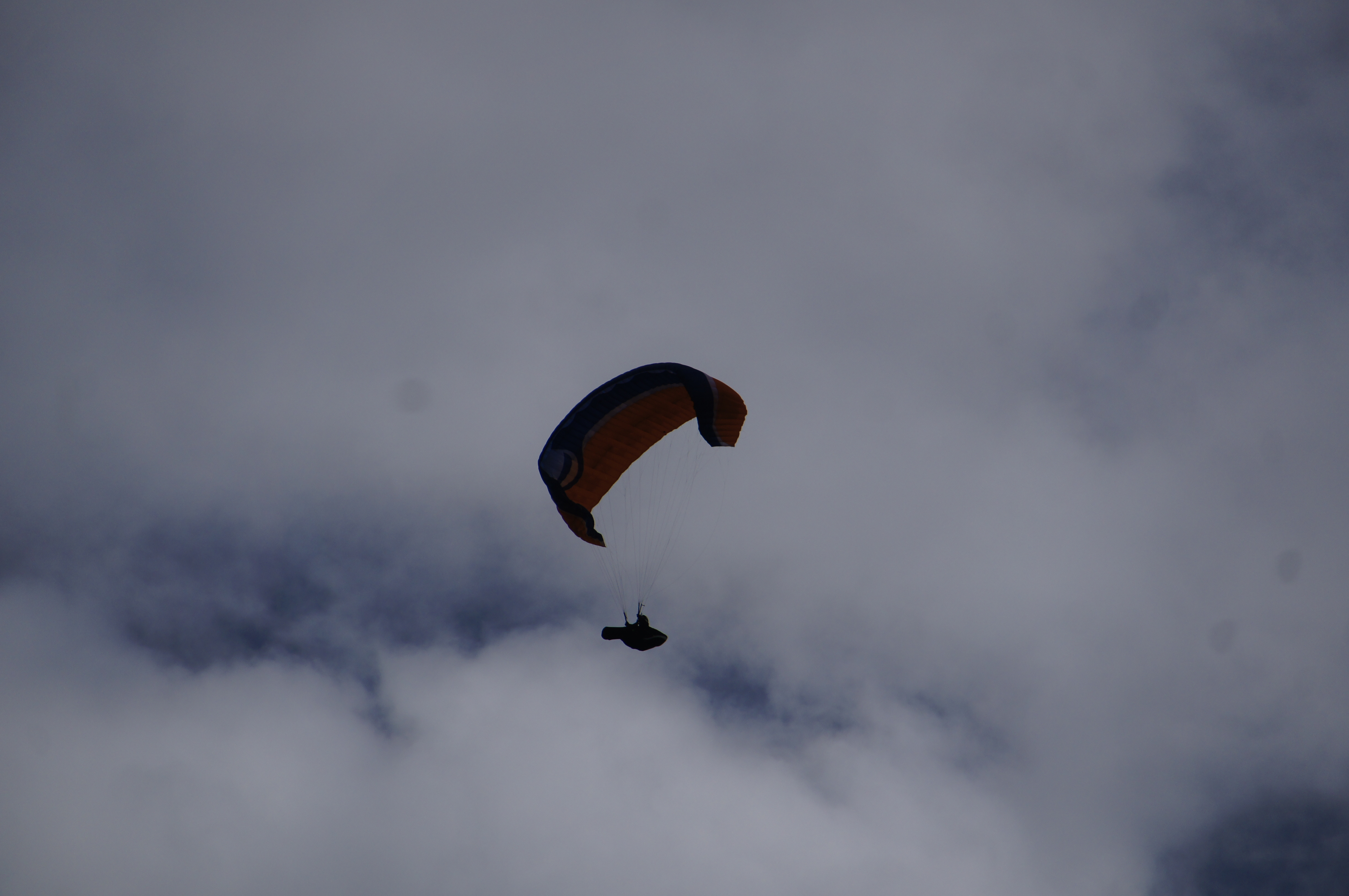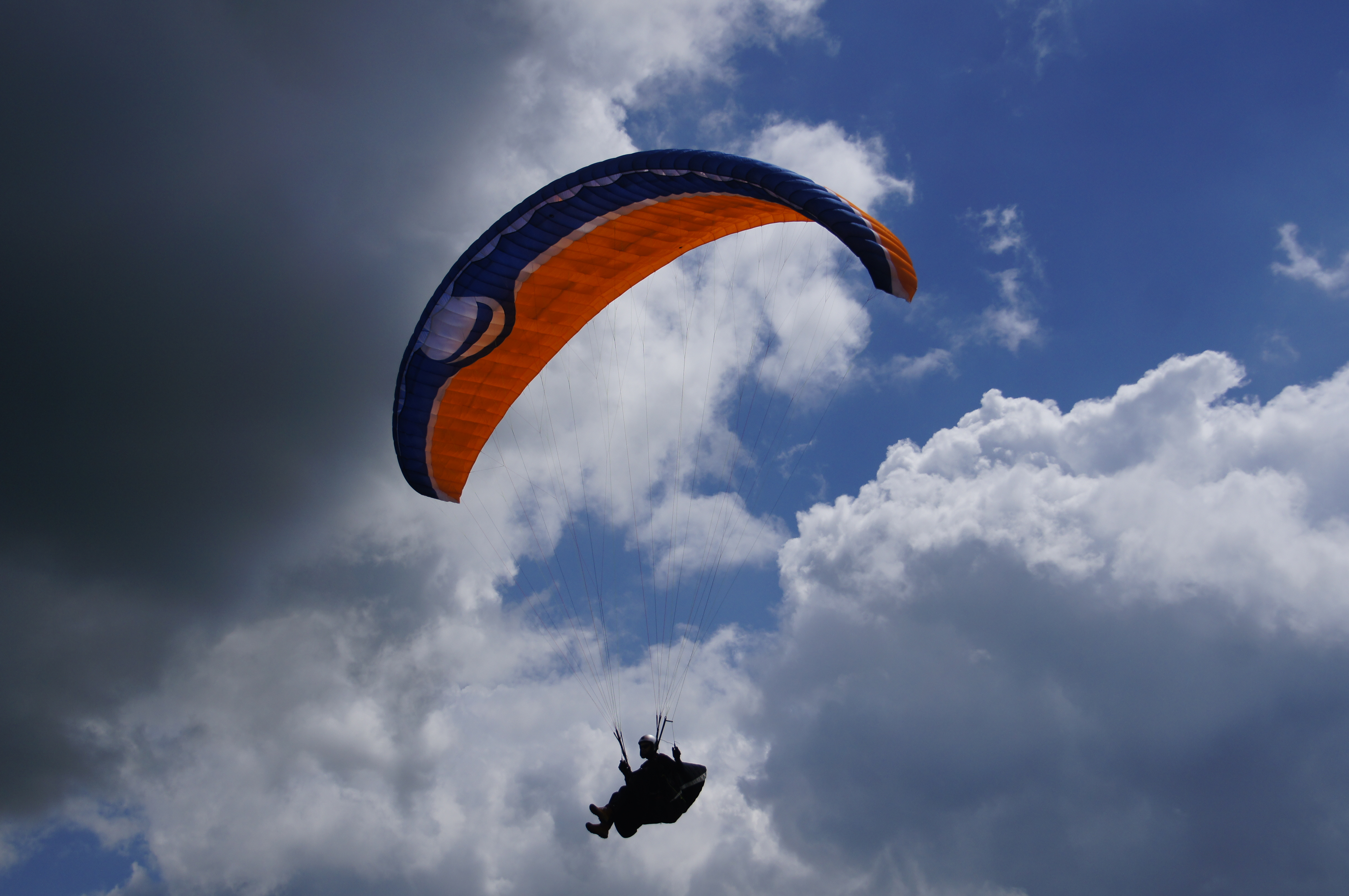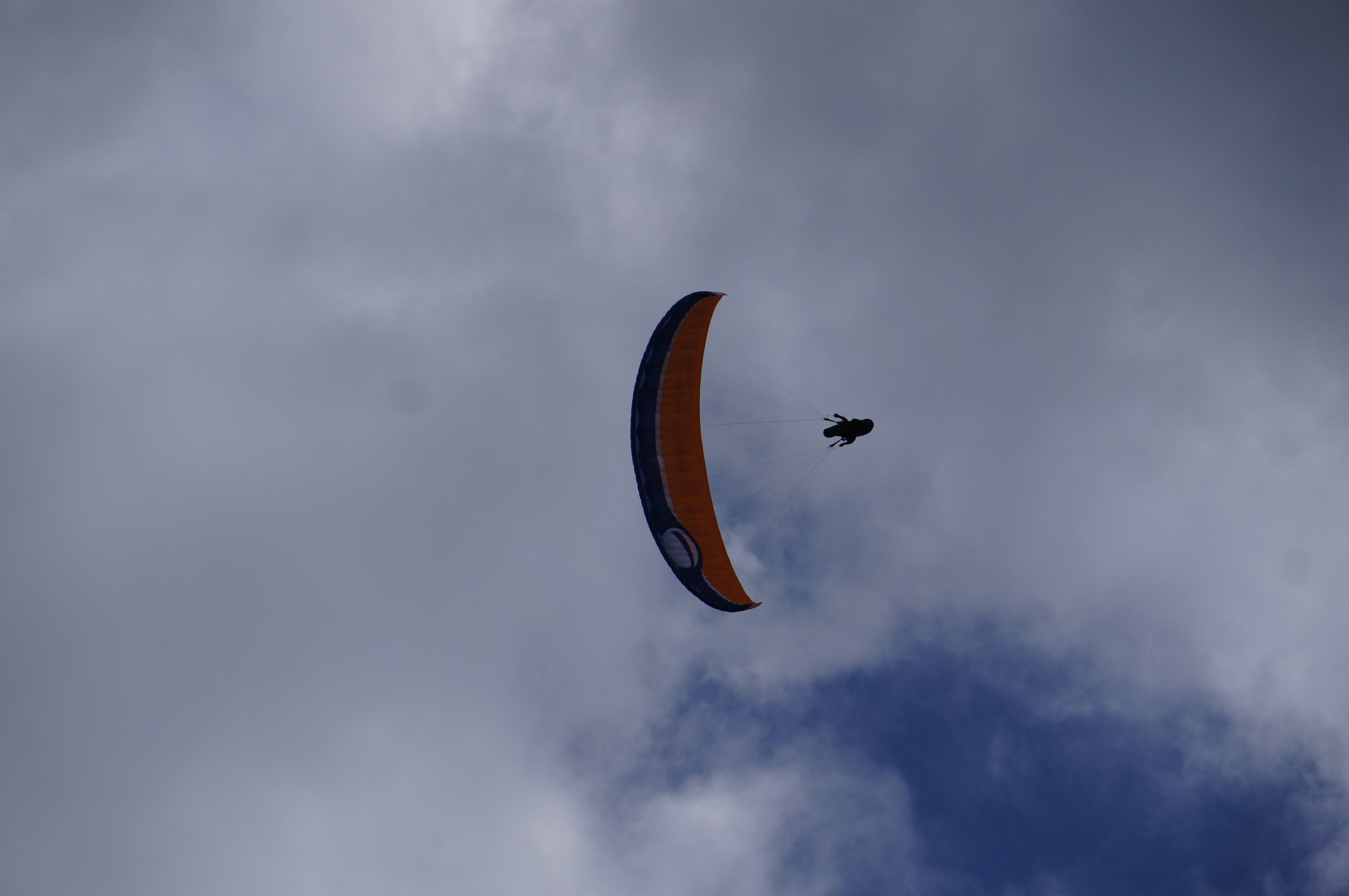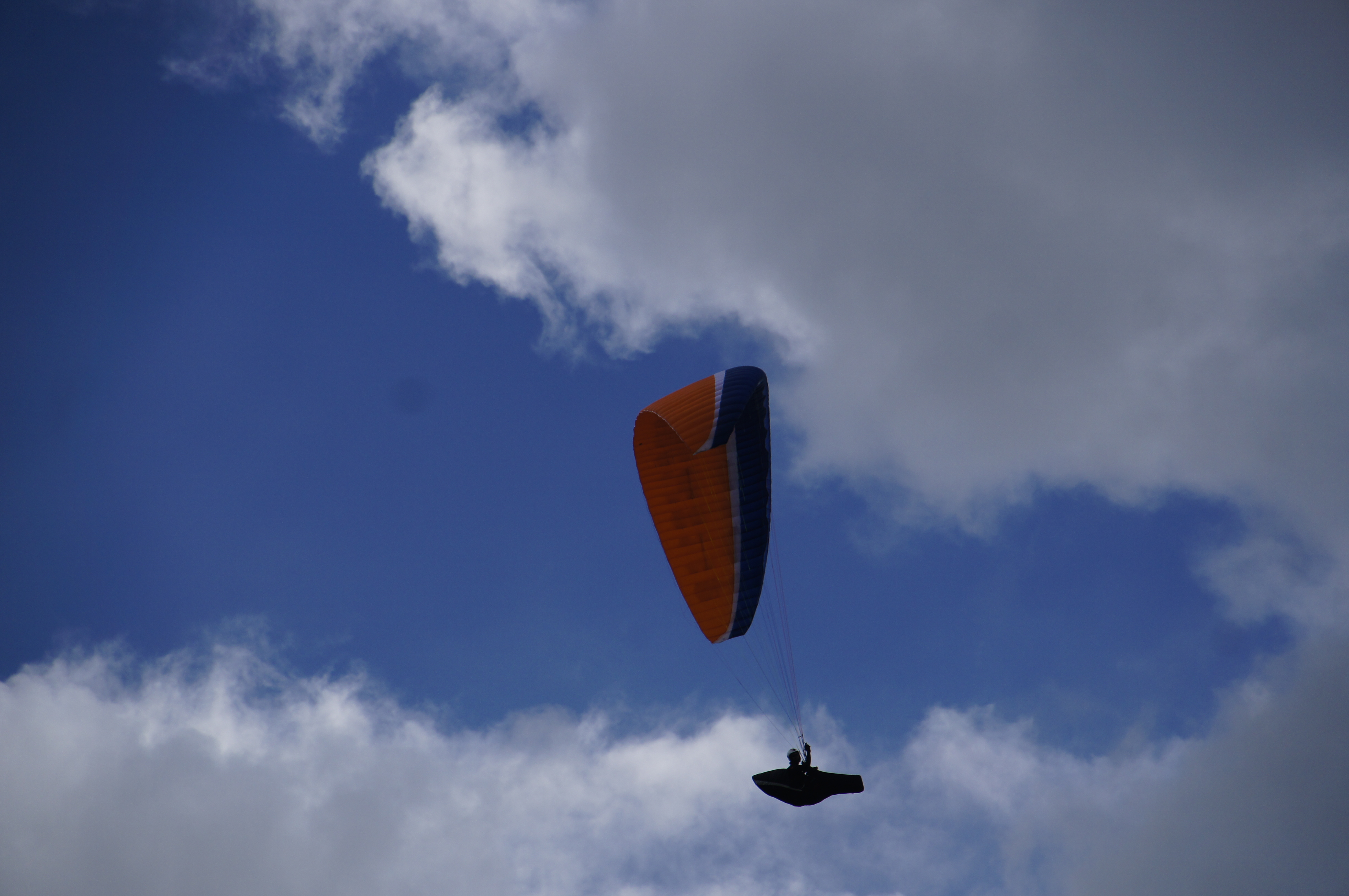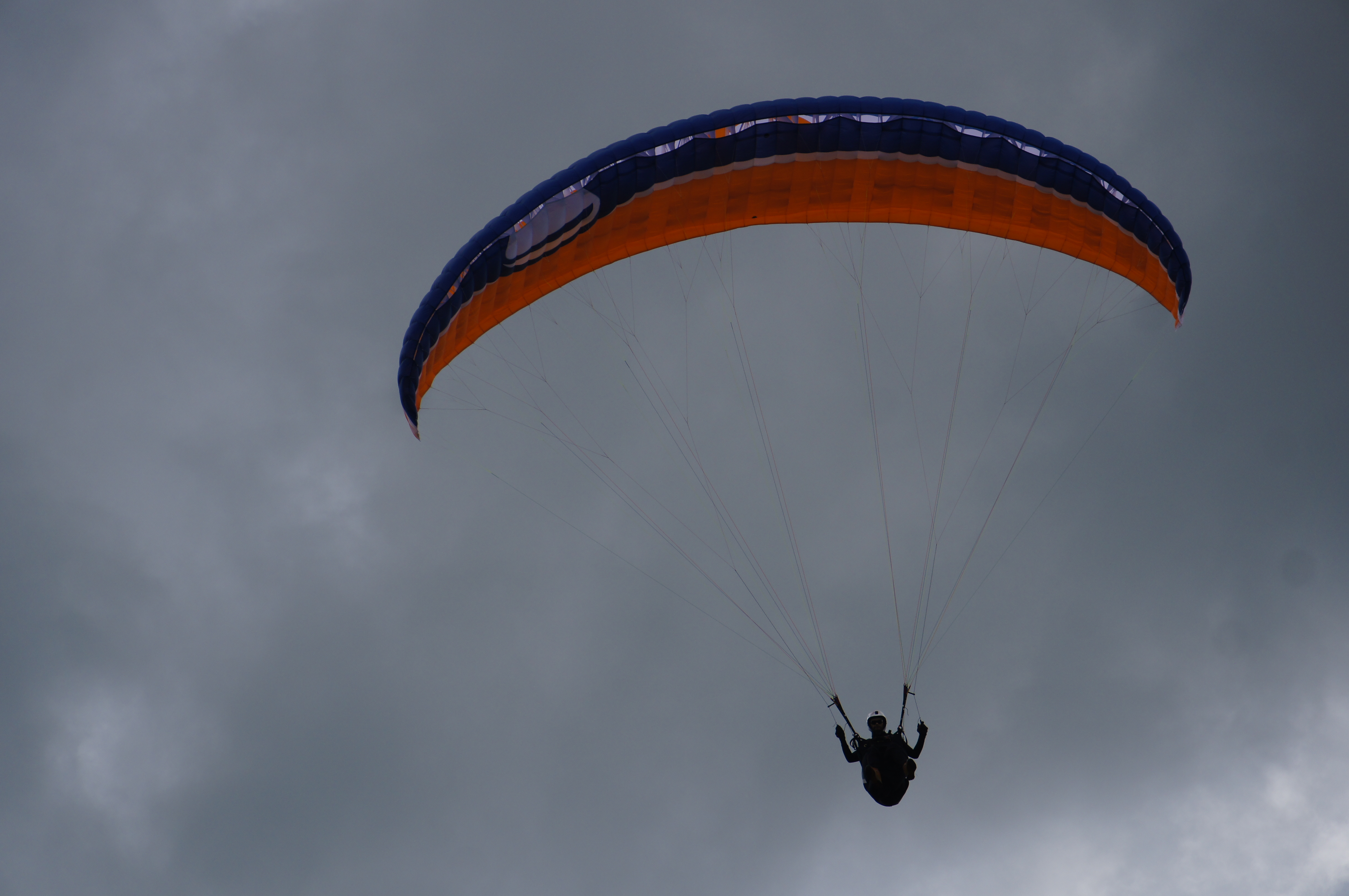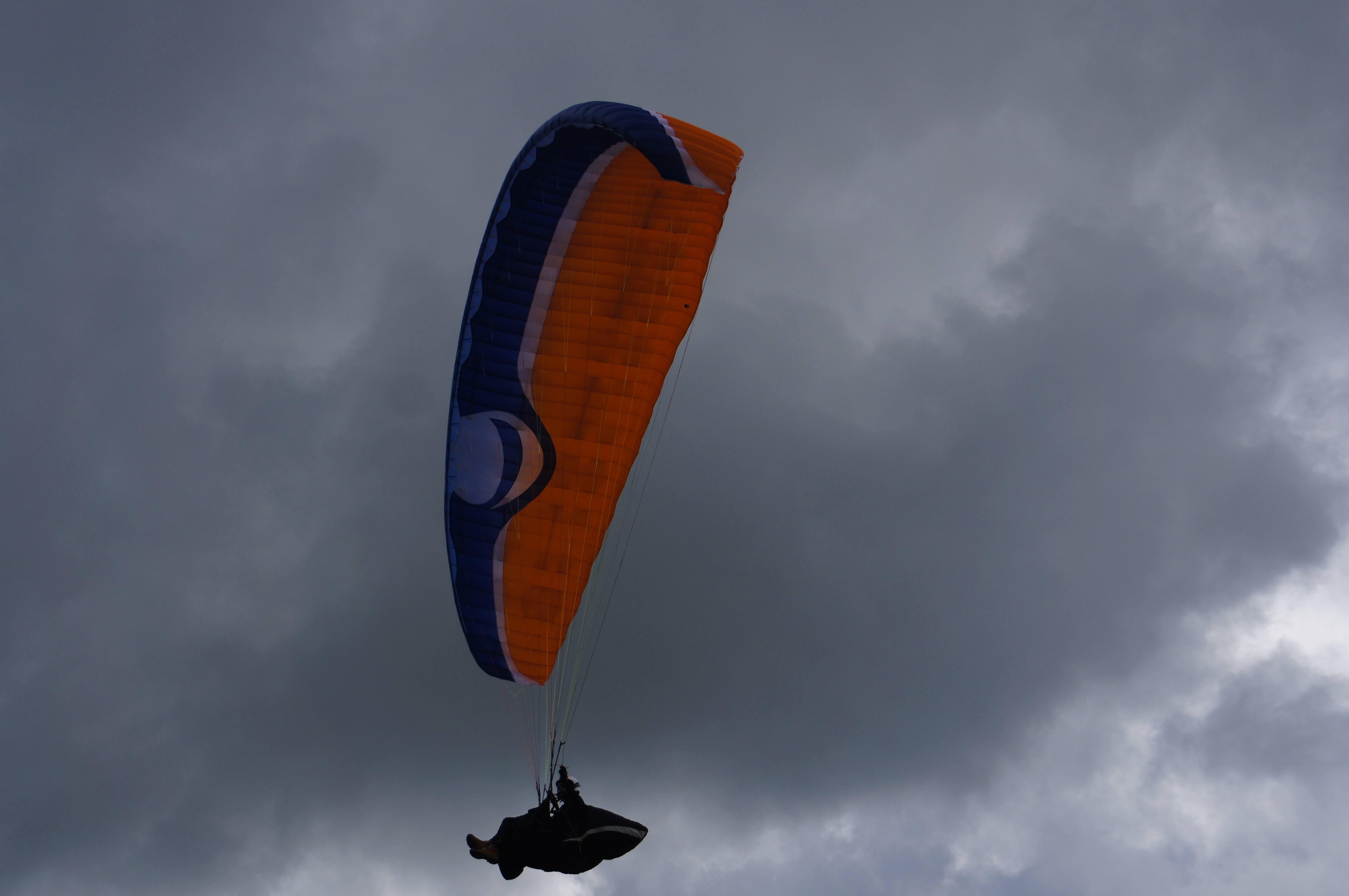Design
A nice blend of moderate innovation and healthy conservatism, so characteristic of Gradient. Innovation - first and foremost is almost inevitable inserts of fishing line, however, quite interesting and unconventional made. Impresses thin webbing for 40kg in the upper tiers of C-rows; however, in the first and second tiers of slinging are rather thick braided webbing, which is quite correct for almost-training wing. Another rather pleasant innovation is the new Skytex Everlast fabric, developed in conjunction with the Gradient and specifically for the Gradient. Golden4 is the first machine made of this fabric, which in theory differs from other Skytex by its more "long-lasting" impregnation. Whether it is true or not is impossible to determine during the test-drive, we have to wait for the statistics from the first owners of this wing.
Golden4 is shaped a bit like the much-talked-of Mentors, which is especially noticeable when viewed from the side by its roughly chopped "ears". Traditional for the Gradient trapezoidal intakes, rather smooth shape of the front third of the chord.
Nothing much to say about the loose ends - a traditional Gradient, high quality, but without features.
Lift, work with the wing on the ground
Very good. We did very well. The glider floats gently, smoothly and distinctly into the flight position, requiring moderate strain on the arms and body, and, having achieved the flight position, does not tend to drop out of it sideways or backwards and forwards. Already on the ground, the influence of the lines is noticeable: the leading edge has the right shape even in doldrums, and it's very difficult to get the subject to fold with the help of rough work with the ends. In response to a rough tug on the A-risers Golden4 smoothly "swims" a meter or two back and forth above the head with a lazy bewilderment, crunching the nervy scythex, and that's all! Of course, if you have set yourself such a task, you can make the leading edge break, but you will have to solve this task purposefully, armed with the knowledge of the wing and with the ability to make a nasty mess of it. If you just switch to "Teapot Mode" and fly it roughly, but without any intention to bring the leading edge down, you won't have any problems. Roll errors are easy enough to correct.
Flight
The ideology of Golden's old models has probably been preserved, but there were some innovations, connected, first of all, with a desire to get more speed, information content and controllability. As a result Golden4 has notably improved its flight characteristics as compared with its predecessors, but fortunately it has not ceased to be a typical Golden family member. Well, or almost typical.
Volatility. Usually it is not required from the "after school" gliders to have some outstanding aerodynamic quality. The task of such equipment is to give a novice pilot an opportunity to join comfortably and safely to regular and sufficiently diverse flights. However, Golden4 was pleasantly pleased with its quality. As you know, it's almost senseless to measure this capricious value in figures, but parallel flights with the more "advanced" machines showed that Golden4 is quite capable to compete with the machines of middle, or even upper Intermediate class. The result is unexpected, but therefore more pleasant.
Speed increase at full throttle is about 13-14 km/h, quite decent result for entry level EN B. Slight drop in quality on the first step of the gas pedal in this class of machinery is gradually beginning to become normal, but still continues to please. What pleased me less was the wing's slight instability at top speed. At full throttle Golden4 tends to flap its ears a little and wobble in pitch. It is not a problem, but it is not comfortable, either.
The rate of descent in pitch-balance mode is normal for the EN B. The Golden4 in thermalspiral seems to need a lot of hand work to maintain reasonable sink rate, but if you get used to the glider's turning characteristics, you won't be disappointed. As we've seen, even a well-loaded Golden4 soars quite convincingly, even in weak and narrow streams, allowing you to spin compactly, but with a slight sink rate.
Maneuverability. For middle EN B the choice of maneuverability characteristics is always a challenge, and it was very interesting to see how a rather conservative Gradient would solve it. The solution turned out to be original and, in my opinion, quite successful. Responsiveness to brakes is noticeable in Golden4 when you move your arms far enough - about 30 centimeters. But there is no backlash! Golden4 reacts very well even at the first few centimeters, but reaction is so weak and slow that you do not have to take it into account. But if you put your hands down, everything becomes interesting. At the same time as there is a considerable load on your hands, there is also a considerable sensitivity to the brakes. At approximately 30 cm the machine reacts to the brakes quickly and even somewhat nervously (of course, in comparison with the classmates!). This is an interesting compromise - on the one hand, you can't blame Golden4 for the lack of brake input, the brake input is even better than average for an after school wing. On the other hand, in order to get the right agility, the right turn behavior, you should pilot accurately, persistently, with enough physical effort. A shy beginner will not be able to fly it in such dangerous situations, and a more experienced pilot will have to use only his hands for maneuvers.
In the thermal spiral I had to find a comfortable steering sling position for a long time. A half-turn reel made the load on my hands and the sharpness of my reactions uncomfortable, and holding the brake handles in the traditional grip meant that I had to lower my hands annoyingly low to pilot effectively. After a few minutes of struggling with the stubbornly difficult thermals, a compromise was found: one turn of the steering line around the index finger. Soft gloves made it possible to keep a comfortable hand position despite the impressive load on the index fingers. A slightly worse option - holding the brakes with two fingers over the grips - would have been more appropriate in a stronger and wider stream.
I liked very much Golden's ability to turn almost instantly in response to a short movement of the hand - not even all "performers" are able to do that. I can't say the Golden4 follows the hand willingly, it's not a very precise glider, you have to make quite a few small steering movements in the thermals. But I wouldn't classify it as a disadvantage, it's more of a feature. It also looks like Golden has a few different turns, like the first Mentor. When both hands are strong the Golden4 is able to glide flat above the pilot's head while maintaining a low sink rate, which makes it suitable for handling weak, difficult flows. A more traditional piloting style with moderate braking of inside arm and almost fully unbraked outer bracket makes it a quicker, more aggressive turn - just right for stronger flows. The machine goes quickly, willingly and even somewhat passionately into a sharp spiral. The main thing is not to overdo it!
Wingovers are also very pleasant - powerful, but clearly controllable in any phase. Golden's weight response is similar to the response to the brakes; there is no unnecessary sharpness, but there is crispness and accuracy. His low-speed behavior is correct - if you have enough power, you can lower the wing with your hands to about 50-60 cm, where you can find the controlled parachuting zone, without risk of tearing the wing off. It is quite possible to bring the wing with both hands to the stall, but it is necessary to make a lot of effort and to spend a couple of seconds to keep your hands somewhere below the suspension seat.
Comfort, informativeness. In this respect Golden4 has somewhat surprised me. Like many other Gradient machines, Golden4 has low stiffness in terms of span - this is partially "to blame" for the very large, unstructured spans. As a result, even a light bounce causes a lot of different wing movements which is a lot of information to the pilot mainly through the free tip load. At first, I was a little dumbfounded by the abundance of information. No, the apparatus does not frighten the pilot, does not twitch or wobble over his head - it "breathes", plays with its "ears" and the load on each strap, and all these small movements are quickly and clearly transferred to the loose ends. For a flight school graduate such squall of information is perhaps even a little excessive, and a more experienced pilot Golden4 will hardly seem "dull" or "boring". Somewhat less information - but still more than average! - comes to the brakes, and airspeed changes are only a small fraction of the test pilot's information content. It is interesting that in spite of some "jellyfish" behavior (to be exact, low swing rigidity), Golden4 is very well damped in pitch and even at roll is almost always above the pilot's head. The roll damping is somewhat worse, but also commendable. Strange mix of high information value and almost total absence of parasitic roll and pitch-in forcing the pilot to learn how to correctly interpret load changes on tips and brakes - very useful when a pilot is just learning to soar in his first thermals. The Golden4 is also very resistant to folding, quickly building up a pilot's confidence in the wing.
Dynamism, capacity. Slightly above average. Everything is normal, clear and predictable. The glider has excellent speed and generously, but not too sharply, converts it into altitude. The exit from the steep spiral when the body returns to the neutral position is very fast, about a quarter of a turn. You don't have to be afraid of sudden unloading, which is inevitable with such rough maneuvers, because Golden4 is very resistant to folding.
Dangerous modes of flight
Asymmetric collapse
Good with a minus. It seems that the test subject's behavior strongly depends on the suspension model and its settings, as well as on the accuracy of the pilot's adherence to the test procedure. A little more than necessary, open chest girth, completely relaxed pilot's behavior - and Golden4 at 60% of range fold can fly quite briskly into an amplitude oblique peck. But if you do it right - oblique pitch does not exceed 45 degrees and directional deviation should not exceed 90 - 100 degrees. Loss of altitude depends on the span of the folded part of the wing, but usually does not exceed 20 meters.
Frontal fold
Excellent with minus. The Golden4 is probably one of the first EN B class machines in my memory with some tendency to parachute after the "frontal fold". But it's better this way than powerful flicks on the opening. The Golden4 has not more than 30 degrees of cleavage, by the way, and after the first, relatively sharp movement the rate of climb and return to normal flight is very smooth.
Thermal spiraling up
Great with Mins. The Golden4's underrun behavior is close to exemplary - there is a "warning" increase in the load on the hand near the stall, and quite informative drop in the load at the beginning of the mode. The exit from the mode does not cause any reproaches either - the kick is insignificant, the speed increase is very fast, without leaving the helix. The only problem is that specifically tuned paddles of Golden dispose a pilot to work very hard and amplitudinously with his hands. Most of the intermediates I know require less hand travel and less strain on the arms when steaming in the thermals.
Fast Descent Modes
Ears
Good. Like on many modern machines with small number of slings, the mode is only feasible at a certain depth of retraction of the "ear" slings, and this optimum has to be felt at the first attempts to work with the "ears", struggling with a slight instability of the mode. Fortunately, the optimal hand position is found very quickly, and in the steady mode Golden4 behaves quite stably. The efficiency of the "ears" is not too great - the rate of descent is around -2. The "ears" open on their own after releasing the "ear" slings, sometimes you may need to use the brakes a little to speed up the opening. Horizontal speed when the ears are folded tends to decrease.
Gas pedal ears
Good. Reduction grows to about -3, overall the mode is quite comfortable. No problems noticed with the exit.
Cool controllable spiral
That's great. Many "intermediates" can already show spiral neutrality at -10, but this is definitely not the case with Golden. At -10 m/s the return of the hull and brakes to the neutral position leads to almost instantaneous exit from the spiral with a pronounced "slide" and strong unloading of the wing, which, however, does not lead to folding. It is desirable to stretch the exit by at least one turn, then everything will be smoother.
Conclusions
"After-school" paragliders are probably the most difficult technique to design. Consistently combine in one wing high passive safety, "foolproof", enough maneuverability and informativeness for a beginner pilot and, finally, to provide decent flying ability - it's a task that not everyone is able to cope with. But Gradient seems to have managed to present quite a successful and quite original solution to this problem. The Golden4 is an honest EN B with decent passive safety, specific handling, tailored for inexperienced pilots, and surprisingly high performance for such a nearly trainer wing. It's not an aggressor like the new Mentors, nor is it a deliberately "bruised" product a la the Gin Atlas. The character of the Golden is quite solid and consistent, and after a little getting used to it, I like it unconditionally. The minimum required is from scratch, provided the student and teacher are adequate.
Pros of
- Great start
- Pleasant character
- Fairly high flying characteristics
Cons
- Not found
I would like to thank Dmitry Gusev, a Gradient dealer in Russia, for providing the machine for the tests.
Thanks to Roman and Natalia Saveliev and Kirill Garevsky for their help with the test drive.
Test drive sponsor: ParaTrack team (Artyom Svirin AkA Bormental, Elkino paradrome).
Photo: Irina Tarasova.

